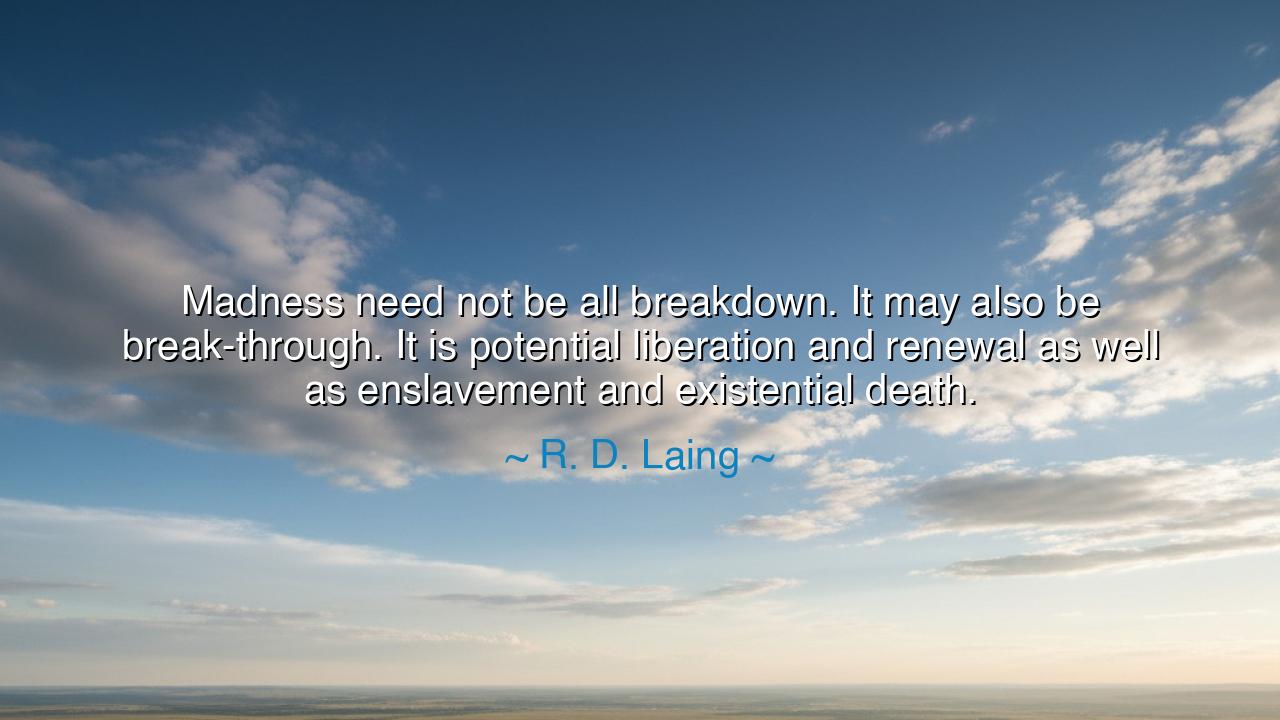
Madness need not be all breakdown. It may also be break-through.
Madness need not be all breakdown. It may also be break-through. It is potential liberation and renewal as well as enslavement and existential death.






The Scottish psychiatrist R. D. Laing once spoke these words with the courage of a prophet: “Madness need not be all breakdown. It may also be break-through. It is potential liberation and renewal as well as enslavement and existential death.” In this utterance, Laing challenged the ancient fear that surrounds madness, that shadow which humanity has always cast beyond the walls of reason. Where others saw only ruin, he saw the possibility of rebirth. Where society sought to confine, he sought to understand. For he perceived that the mind, when it shatters, might not merely fall into darkness, but instead burst through the limits of its old world into a greater, more terrible, and more beautiful one.
The ancients too understood that within chaos lies creation. The Greeks told of Dionysus, the god of frenzy and divine ecstasy, whose worshippers danced on the edge of sanity. To them, madness was not always a curse—it was a visitation, a trembling communion with forces greater than the self. Even Socrates, the most rational of men, once declared in Phaedrus that “the greatest blessings come by way of madness, when it is sent as a gift of the gods.” He spoke not of destruction, but of transformation. For to lose one’s old self is to make room for something new—a vision, a truth, a liberation of the spirit from the prisons of convention.
Laing himself lived in an age where the human soul was increasingly measured in diagnoses, its mysteries dissected by cold instruments of science. He dared to suggest that mental illness could sometimes be a form of spiritual crisis, a cry for truth in a world that had forgotten how to listen. When a man or woman breaks under the weight of existence, Laing saw not only collapse but the possibility of a break-through—a chance to awaken to deeper realities, to question the illusions that bind us to conformity and despair. It is a perilous passage, yes, for many are lost within it—but those who return may come back renewed, carrying the strange fire of understanding.
Consider the story of Vincent van Gogh, the tormented painter who wandered the valleys of despair yet beheld the heavens in their whirling glory. The world called him mad, yet through his turmoil he saw the radiance of existence that others could not. The very madness that broke his peace also broke open the veil of ordinary sight. In his agony, he found creation, and through his pain, the world gained visions of sunflowers that pulse like living suns, and starry nights that seem to breathe the soul of the cosmos. Van Gogh’s suffering was both enslavement and liberation, both existential death and resurrection—just as Laing foretold.
The truth within Laing’s words is this: the journey through madness, whether of mind or of life, is a path through the wilderness of the soul. When the structures of reason crumble, what is revealed is our naked being—stripped of all masks, all pretenses. Many fear this void and are consumed by it, but a few, guided by courage or grace, discover within it the seeds of a new self. Thus, what appears as breakdown may in truth be the breaking of chains—the potential liberation of one’s deepest essence from the prison of falsehood.
Let us not romanticize suffering, for madness can indeed destroy. It can enslave, isolate, and extinguish the flame of being. Yet even in destruction, the possibility of renewal waits like spring beneath the snow. The task of the wise is not to condemn those who wander through the shadow, but to hold a light for them—to see not monsters where there are only wounded souls, to recognize that every collapse hides within it the longing for wholeness.
So, to you who walk upon the edge—do not fear when your world begins to tremble. When all that you know begins to dissolve, remember that the breakdown may be the prelude to break-through. Do not flee your pain as though it were an enemy; rather, meet it as a teacher. Ask what must die within you so that something greater may be born. Seek stillness amid the storm, and know that even the fiercest winds can cleanse the sky.
The lesson, then, is this: madness and renewal are twins, born from the same womb of transformation. When life shatters your certainties, do not despair—kneel among the fragments and listen. From the ruins of your old mind, build a temple for a truer self. And when you rise again, do not forget those still lost in the dark; for you will have walked the same path that Laing described, where death becomes renewal, and despair becomes awakening.






AAdministratorAdministrator
Welcome, honored guests. Please leave a comment, we will respond soon